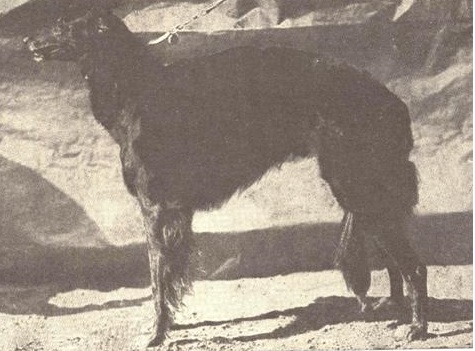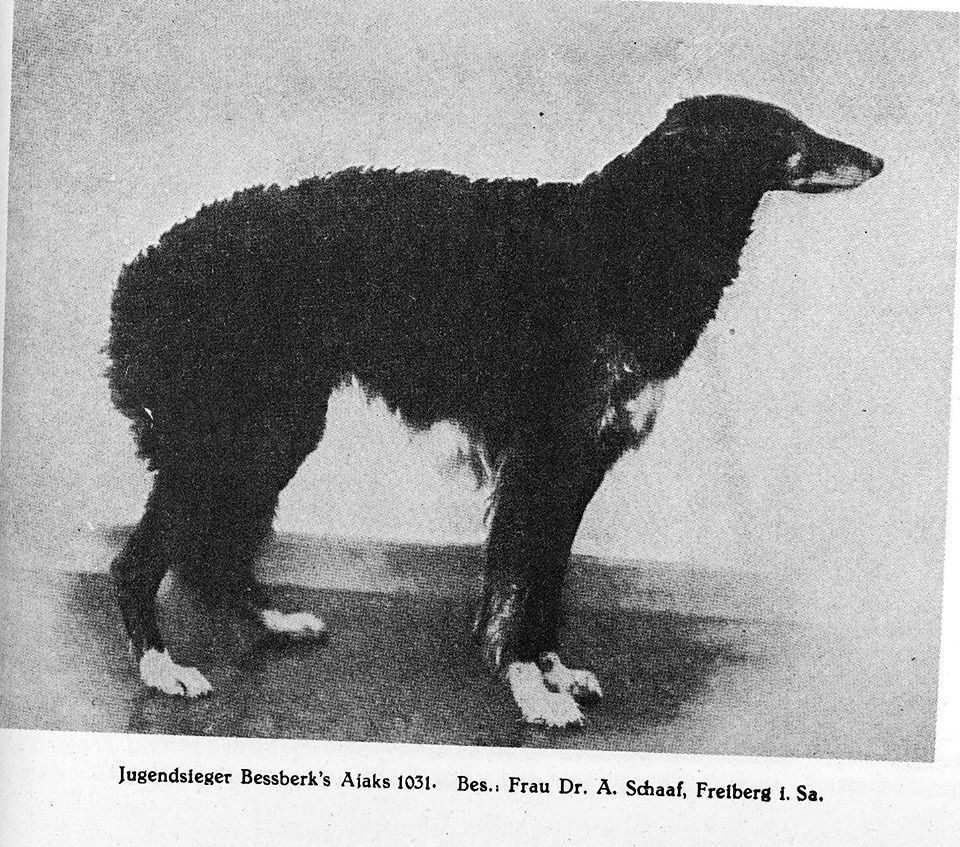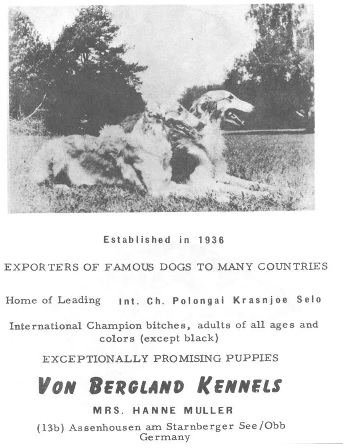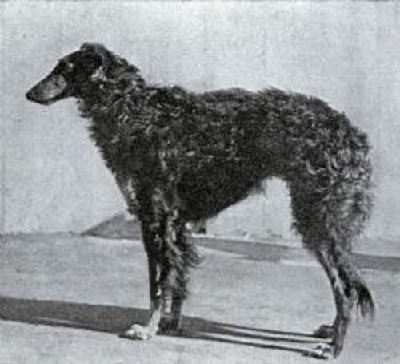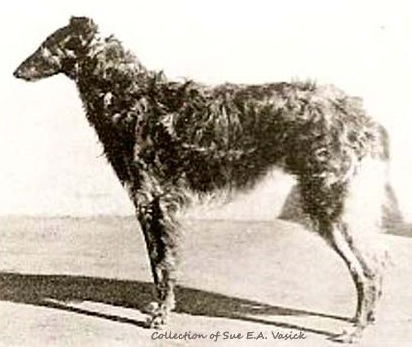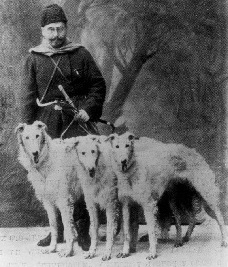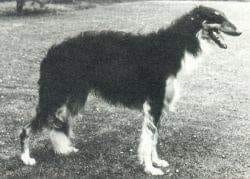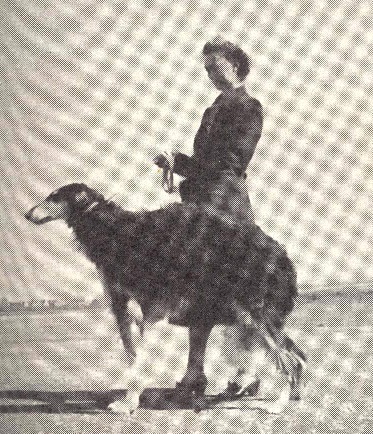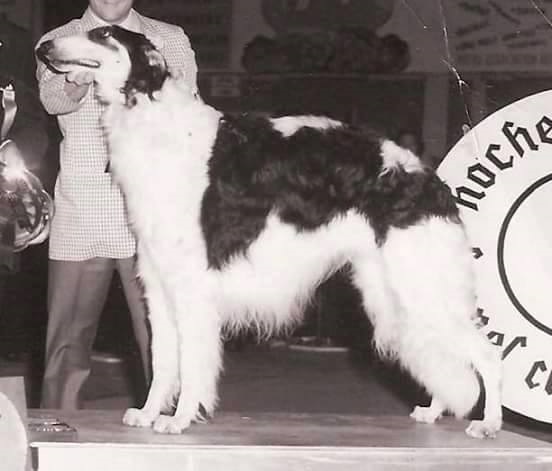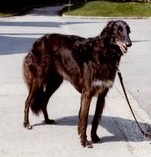Very little distinguishes a borzoi from the year 1900 from a borzoi in the year 2000. When we look at other breeds we will almost always see alarming differences. Why is the borzoi so consistent in type over such a long period of time?
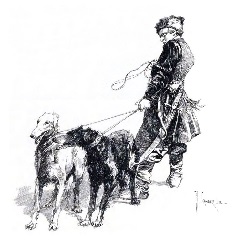
We owe this consistency and the high level of soundness to the Perchino hunt of Grand Duke Nicholas, Dimitri Walzoff and a small number of hunter/breeders surrounding Perchino. In the short period from about 1870 to 1915, by breeding a large number of borzois in all colors, including black each year and through scrupulous selection of only the fittest, they managed to establish the breed at a class of its own.
The borzoi has its roots in Russia. We have learned from articles, books and pictures that borzoi had existed in Russia for many generations. We have also learned that the name Borzoi in Russia had about the same meaning as Sighthound in the west. (In English, borzoi is often translated to Greyhound, whish gives a totally wrong association). Several different types of Borzoi existed, which would have a significant effect when the breed later was restored. Some of the hunting families like the Kareef’s had bred borzoi and hunted since early 1800 and there are signs that the breed has existed several hundreds years back in time.

Above is an example of very early (about 1835) borzoi given by the Imperial Hunt Gatchina to Duke de Nemours in France. The Duke bred from the Tzars dogs and one of the puppies was given to Prince Albert in Great Britain. A borzoi was a royal gift and in modern times, Boran, given by the Russian Prime Minister, Chrusjtjov to Lord and Lady Stenberg followed the tradition.
Note that the dog, unfortunately without a name, was said to be black and tan with only a small white spot on the chest. The description of the dog tells us that at Gatchina, as far back as 1830 bred self black sighthounds. “It was large, 3 feet high (perhaps to top of head) with LONG ears and a furry, foxlike tail”.
A borzoi? I don’t think so, most certainly a type of sighthound (Crimean?) found in the vast land of Russia!

Nearly every Russian nobleman had his estate with hounds and horses. Hunting with borzoi was a sport, an aesthetic experience that appealed to a class of local sovereigns. The noble land owners owned the land and everything on it including people, and wanted to distinguish them self from the other hunters. One way to do this was to breed borzoi easily recognised from others, by size, type or color.
It is said that the original “old” borzoi was light in color, white with spots of grey and yellow. The black and tans in particular were, by many, seen as not purebred.
In the years after 1861, when the serfs were set free and the landowners abandoned their estates, the breed was nearly wiped out and only a few hunters went on breeding and hunting with borzoi.
The pictures from the Martynov portfolio illustrate some of the varieties at the time when the restoration of the borzoi started (in 1870).
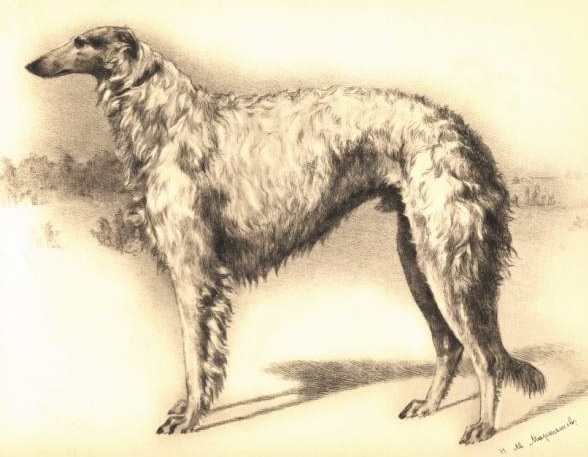
Pobedim (Kareef) we use as an example of the old type borzoi both regarding coat and color.
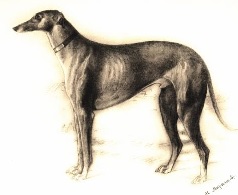
Maltchik (Scheremetyeff) can illustrate that even well known breeders in the old days used and bred from greyhound-like and saluki-like hounds.
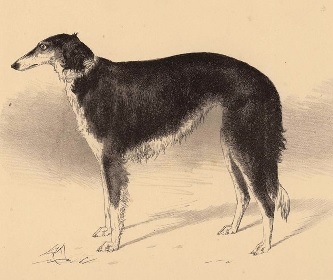
Shutka (Kozlov) can illustrate the black borzoi which was not supposed to be found in the ancient, purebred Borzoi. (Won a big silver medal in 1880)
The sighthounds from different regions of Russia had different characteristics compared to the Russian Gustopsovoi Borzoi. This could be shape of head, set of ears, carriage of tail, hunting abilities and color. Can we suspect that English Greyhounds had an influence on the black color in borzois.
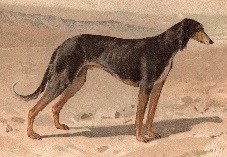
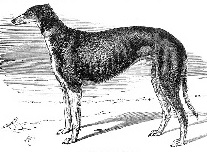
We know that borzoi of different colors were used by the breeders during the restoration of the breed but also that lighter colors were preferred. Quite a few self colored was sent to the west and we can only wonder why.
Had the Russian breeders in mind keeping the best of the “old” type borzoi to themself and selling “surplus” dogs abroad or give to “small hunters”? Hunters who did not breed but kept borzoi and took part in hunting parties organized at the large estates.

From “The Perchino Hunt” by Dmitri Walzoff we can read about this:
“In order to retain in the Perchino hounds, the conformation and field qualities which their owner has always wanted to see in them, particular attention has to be paid to the selection of breeding dogs and to the selection of puppies and their training. For keeping up the full strength of the packs, it might suffice to bring up twenty-five to thirty young hounds annually in order to replace those that become too old or which actually rendered unfit for hunting. In order to maintain the desired type of these thirty hounds, sixty, and sometimes eighty puppies have to be brought to maturity to meet the exacting requirements of a passionate keen hunter.“
Andrus Kozlov, expert on borzoi history and with access to old material from earlier hidden archives including Perchino, wrote this:
“There were a lot of dogs in Perchino, new ones were born every year. Regularly a list was compiled of “defective” dogs and these dogs were sold or donated.”
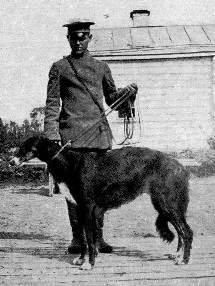
From Raketa Perchino’s first litter 6 out of 8 puppies were classed as “defective”, not because of their color (Raketa belonged to the Grand Dukes own special pack) but meaning they simply were not good enough.
We don’t know if the other major breeders had the same critical “selection” criterias as Perchino. We can, however assume, that during the breeds reconstruction after 1861, culling of puppies and selection of breeding material was carried out to a large extent. We can also be very certain that material kept for continued breeding was the best, both according to the “the old Gustopsovoi borzoi”, but even more according to health and soundness.
However, the revolution must have changed all planning in that direction. The result being that borzoi were sent abroad without any discrimination at all. One can perhaps say that the worrying times in Russia just prior to the revolution resulted in a number of good borzoi sent to the west, but perhaps also a number of not very good ones, as well.
Quite a few of the borzois imported to the west where self colored in a variety of colors, including black. One of the more famous of these early black borzoi was Argos (Sokoloff) born as early as in1886 and first sold to Grand Duchess of Newcastle, then to Mr. Huntington in America, re-named with the spelling Argoss. Other influential early imports to America were Zyclon Perchino, a self brownish black and Yarki Perchino, a self grey.
A very influential self black was Chack Bielaja. He was bred in Germany by Richard Dix of Bielaja kennel by a Russian imported self grey dog, Vigow (Ronne), bred in Kiev, then in Russia. All records of his pedigree are lost but, he is believed to have been born in 1908. When imported to Germany he was renamed Vigow von der Mauritzburg.
There is a little mystery with Vigow, the father of Chack. He sired only one litter according to the studbook. Bred to Marza Steinach Bielaja (black and white), a litter of four (2+2) was the result. Three was black and white and one self grey.
They were registered as black with white. From the studbook we can be see that only Chack was bred from .

The mother, Marza had a pedigree dominated by Russian imports, several black and whites but also at least one self gold. Vigow was reported to have been self grey or silver. He should therefore not have been able to produce self blacks; the answer to this is perhaps found in what Bonnie Dalzell writes about the dominant black.
From this it is quite possible that Vigow von der Moritzburg in fact was a self chinchilla (silver) and therefore could produce the self black Chack Bilelaja who in turn produced several self blacks. As Marza Steinach Bielaja most probably was black and tan, it is most probably that he was a heterozygous Self black.
When looking at the picture of Chack Bielaja we can see a little white on the chest and on the left hind foot. There’s no doubt that he was a Self Black as an adult dog, but on a picture at 4 and a half month he is in fact silver grey. Click on his name under the picture and read more.

We can wonder what his breeder Richard Dix saw in him and why he was such a popular stud dog. He sired more than 14 registered offspring in the studbook from 1913 to 1919. (See article on Chack Bielaja)
He looks like a very young dog in the picture (22 months). The head looks fine and as the coat is short, we can imagine that the chest will be deep enough, but the front was not good. I am quite sure it must have been the color or the whole body marking the breeders wanted and not the front. It could also be they knew something about his sire Vigow that has been lost since then.
At this time there was a number of dogs imported from well known breeders in Russia including Perchino. We can only wonder what Richard Dix and the other breeders where looking for?
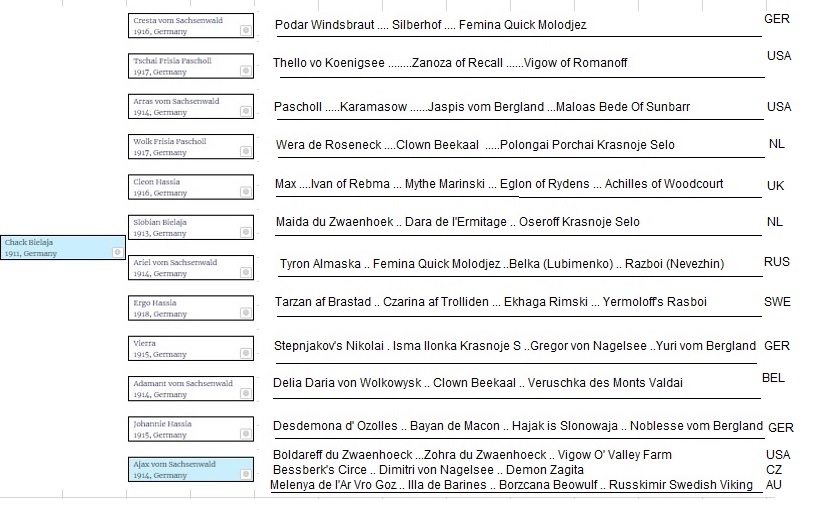
Chack was bred to four bitches, one the white and red Sascha von der Pegnitz to produce the white and red Slobian Bielaja. He was bred to Kaja Pascholl and produced a litter for the Hassia kennel of grey and fawns. When bred to Mara Pascholl it resulted in the Irish red Wolk Frisia Pascholl. It was when bred to the grey sable Isma Beresina that the self blacks Arras and Ajax, the Irish black and tan, Cresta, and the self grey Adamant – all vom Sachsenwald – were born.
From the above list of 12 offspring from Chack Bielaja, all were bred from and many of their offspring were bred from, as well. Ajax and his son, Bessberk’s Ajax, were both frequently used as stud dogs.
Another line goes from Chack Bilelaja through Arras vom Sachsenwald, to Divia Frisia Pascholl, to Atlan Pascholl to Meesko of Shay exported to Australia. However, the dominant black color seems to have been effectively lost so even the Australian born borzoi came out in other colors.
The offspring of Chack through both Arras vom Sachsenwald, Ajax vom Sachsenwald and Tchai Frisia Pascholl, led to the famous Vigow O’Valley Farm in one line and when adding one more line it led to America’s number one Borzoi all time, the all white, Vigow of Romanoff.
After 1924 when Boldareff and the two brothers Sheremetieff wrote the new UICL standard for borzoi it was almost impossible to find a self black or an Irish marked tricolor borzoi in Europe for the next 30 years. That goes for all breeders, also those who used Chack Bielaja and his offspring. The respect for the Russian breeders must have been great to the extend of glorification and one can wonder were critical thinking and fear of consequences was hidden during this period.
According to the “Rules of color” discussed earlier there must have been a great number of black and tan colored puppies born and tragically, during the 1930’s, 40’s, 50’s and 60’s, to avoid the “not wanted” colors to grow up, they were perhaps classed “defective” as we saw from Perchino. We must not forget that the two World Wars restricted breeding, especially in Europe.
Miss Murray, the famous English borzoi breeder and owner of the Fortrouge kennels, once told that she owned borzoi before the WW2, but could not keep them in London during the war and had them sent to Ireland for safekeeping. It’s a miracle that so many even managed to breed with with the war going, almost around the house.
It is perhaps a bit surprising to know that in the years between 1940 and 1945 a number of Borzoi were still being born. These figures are approximately.
The Sovjet union: 80 England: 575 Germany:763 Belgium: 27 France:19 Holland: 7 Australia: 64. USA: 590 for the same period.
The most surprising in these figures are that in both England and Germany very large numbers of borzoi were bred, even if, as Margaret Davis says, “many breeders took the chance when the war was about to end in 1944 – 1945, to breed before the dogs became too old”.
One of the other dogs mentioned in the beginning of the article was Argos (Sokoloff), a self black and tan or tricolor; it has been indicated that he was bred from in Russia before being sent to the Grand Duchess of Newcastle in England. From what is known, he was not used in England before he was sold to Mr. Huntington in America.
From the picture we can see that Argos had the typical markings of a black and tan on his cheeks. He also had white trimming.
The father of Argos, Ataman I (Boldareff), (there is a debate if he was a a grey sable or a black and tan) was born in 1885, and represents a line of the highest importance to the borzoi breed.
The Duchess of Newcastle said on occasion that she did not always care for the borzoi sold to the west by Grand Duke Nicholas at Perchino (see above about the defective list), she would rather import from the same breeders where he got his dogs from. This chart shows this very clearly. She imported Ooslad and Argos, two of the best borzoi ever exported from Russia. We can say that the litters of Ataman I (Boldareff) make him one of the PILLARS the breed stands on.

From Aspid (Walzoff) it leads to Golub Perchino and from Raskida (Sokoloff) to Strela Perchino. From Golub and Strela came litters of nearly perfection. All living borzoi have these dogs, leading back to Ataman I (Boldareff), several hundreds, perhaps thousands of times in their pedigrees.
Ooslad (Sokoloff), who went to England and became a Champion, sired four litters and thirteen of the pups are in the studbook. His son, Windle Earl, became the father of more than forty borzoi, Windle Queen nearly ten, Brincliffe Earl sired four and Circassian Queen became the mother of one
Margaret Davis found during her research of Russian bloodlines that Argos, before he was sold to England was bred to Milka Sorokthin and sired Alma (Sorokhtin, Argos II (Sorokhtin) and Nakhal (Sorokhtin). If this is correct it leads to the borzoi bred by the Nevezhin brothers in the 1950 and is still very much alive in modern Russian borzoi.
Argos (Sokoloff) was purchased from the Duchess of Newcastle by Mr Huntington in America and when registered with AKC he was renamed Argoss.
Argoss sired litters in America and he was also went to Canada and sired litters there. He is a very influential factor in the breed and can be found in many of the best known bloodlines. 20 of his offspring can be found in the studbook
Tsyclon II Perchino was renamed Zyclon of Pechina when registered in America by Joseph Thomas of the Valley Farm kennel.
Yarki Perchino was imported about the same time by Joseph Thomas and he was renamed, Yarki of Perchina.
The reason why the world famous Perchino borzoi could not keep their names when registered in America was because there already existed a kennel of that name owned by Miss Lois Kellogg..
This article is about the black borzoi but apart from the first generations by the self black Chack Bielaja and the black and tan Argos we have almost only seen silver, grey, gold, red and shades of yellow. Some of these was self colored but hardly any were black. One question we can ask is, where did they go?
To understand what happened to the black color in borzoi in Europe we need to go back to the rule of genetics. In 1924 there existed a great number of borzoi descended directly from the best Russian bloodlines. We know that in Russia after 1870, borzoi were bred in black, red, and a variety of shades and markings from self blacks, silver, gold to all white. We also know that breeding from combinations of these colors, a number of puppies with black in some form will appear at least in the early years. The dominant blacks are the easiest to sort out and once gone, they will not show up. At least one parent needs to be dominant black to produce one. The black and tan is much harder to get rid of as the reds can produce black and tans. In the period from 1925 onward it’s hard to find black and tans. There must have been quite a few born, but very few turn up in the studbooks.
Purists in all shades have always existed, so also in the small world of borzoi. In the 150 years since the restoration of the borzoi began in Russia there were people who wanted back the old Gustopsovoi borzoi but also the more pragmatic breeders that bred for type and soundness and didn’t mind the darker colors.
Igor Solovjev was a scholar from the Maxim Gorky Literature Institute and a well known breeder and kynologist in Russia after WW 2. In 1970 he wrote an article dedicated to Jo Heller of Vorenoff kennels in support for her long fight for the black colored borzoi.
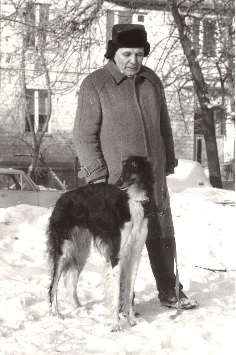
He tells us how the Russian hunters wanted to breed dogs easily recognized from other hunts by color, shape, coat etc.
He writes about a kynolog, well known in the early years, L Sabanejev who described the colors in the borzoi. He mention the greys, whites, reds but also brown and blacks. He concludes that the lighter colors come from the northern type of hounds of Laika type while the darker colors comes from English greyhonds and Polish Chort hounds. The sables with the typical markings on the forehead “widows peak” was a sign of eastern hounds, while black and tan came from the Crimean sighthounds.
Sabanejev out of this used the expressions Wanted and Unwanted colors. He seemingly became very occupied with his ideas that the old Gustopsovoi borzoi was a mix of eastern sighthounds and wolf-like northern hounds. What he did not realize was that in the northern hounds all colors could be found, including blacks.
Solovjev thinks that the highly respected Russian huntsman Matchevarianoff came closest to the truth, sayng that the borzoi comes in nearly any color from white to black and that he himself bred without discrimination.
Disputes on the color continued frequently to the time of the revolution but it was also a fact that at the exhibitions in Russia there was no discrimination of color. Blacks and black and tans received the highest prizes for quality alongside other colors. (see Shutka (Kozlov) winner of big silver medal), and Raketa from Grand Duke Nikolais special pack.)
When N Ermolov in 1888 wrote what we can call the first standard, it says of color: Today the borzoi comes in many colors and one should not be too particular on this.
Another well known breeder, S Ozeroff, was even more outspoken: “let the hunters who breed for fashion, today fawn, tomorrow grey, tell you that your (dark) borzois are no good and worthless. It is far more important to breed for harmony and agility than for a certain color”.
When UICL the European Sighthound Society wanted to update the standard for borzoi, Mr. Artem Boldareff, Count Boris Cheremeteff and Count Dimitri Cheremeteff were asked to write the standard. They must have seen this as an opportunity. The reconstruction of the borzoi as they wanted could no longer be carried out in Russia, the breeders were gone. The standard they wrote could be seen as a tool to continue that work. (Click the picture to the right to see presentation of Boldareff. Click the text to see the standard from 1924 ).
Mr. Boldareff was very much criticized for the way colors were described and had to defend it several times.
It is also interesting that Nikolai Tchelichtseff, who stayed in Russia after the revolution and acted as an expert and adviser when breeding started again in 1922 to 1925. He advocated firmly for the light colored borzoi.
Igor Solovjev concludes in his article that the borzoi in Russia was developed through more than a hundred years and that other hounds had been used and bred to when needed.
“This mixture is why the borzoi is what it is with all its virtues and faults”.
Where stands the black borzoi today? One could say that color is no longer being questioned, breeding for color is accepted but never was and never should be the purpose.
As we have learned, some still think or believe that the lighter colors is a sign of “pure blood”. The problem is that all living borzoi are related and the common denominators are not that many. If we limit the number of ancestors to borzoi produced in Russia from about 1870 to 1917 and bear in mind that in order to secure and stabilize the reconstructed borzoi, some heavy inbreeding was necessary. This and two World Wars which effectively reduced the gene pool means that all colors and in fact all types are there. The use of frozen semen has increased this to a degree where no type or no line of borzoi stands out genetically.
Over the years since after the first WW breeders have been under influence of ideas and fashion. In Europe this resulted in the elimination of the black and black and tan borzoi.
Happily these ideas were not as wide spread in Great Britain even if the Duchess of Newcastle said that she tolerated all colors but did not care so much for the blacks. For some reason we find many dark colored borzoi in England after WW2, even a growing number of self colored black, tan and whites (tricolored) but hardly any dominant blacks. The reason for this can not be genetics alone but do perhaps have something to do with personal preferences from the breeders.
In America did the dominating kennel, O’Valley farm of Mr Thomas purchased borzoi of different colors from Grand Duke Nicholas and other breeders in Russia as well as from Europe. It was perhaps the light colored that became best known also for the successor, Romanoff even if occasional blacks turned up like Black Belle of Romanoff who is still found through, among others, the Alpine kennel and it’s successors!
Louis Murr, the owner of Romanoff kennels, bred a very interesting litter, linebred on the dominant black Chack Bielaja, resulting in, among others, Vigow of Romanoff, Otrava of Romanoff and Akuratni of Romanoff. All were light colored and are still very much present in the USA and in the whole world through the Majenkir, Tam-Boer, Barnaigh, Winjones and other well known kennels.
Akuratni of Romanoff was sold to the Barnaigh kennels in Scotland in about 1934. As said above, he was linebred on Chack Bielaja and when the famous Winjones Ataman was born 1946 he was in his turn, linebred on Akuratni of Romanoff.
Ataman’s bloodlines were influential in his homeland England and also had an impact on some of the lines of black borzoi in the US and even in Australia.
With the variety of colors in the early American borzoi, including the self brown Zyclon of Perchina and self grey Yarki of Perchina we could expect offspring in all colors including blacks. There were blacks, especially in the early generations. One dog stands out, Black Falcon of Twin Elms from 1953. In his pedigree we see mainly “old” American bloodlines going back to O’Valley Farm and the Russian Perchino imports and the offspring of Chack Bielaja.
Via several black, tan and whites on Sunbarr, Malora and more imports from Europe came a number of high class tricolor borzoi from the Sirhan kennel of Audrey Benbow in Canada.
In Canada did the Kishniga Kennels of Richard Meen an John Reeve-Newson continue to breed very fine tricolor borzoi, much on the same lines as the Sirhan kennels.
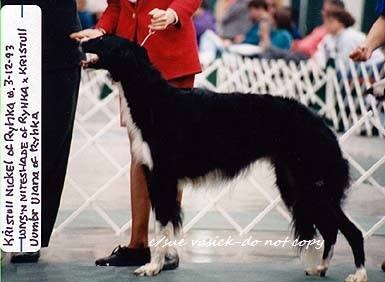
Modern self blacks became more common in America, an example is, Kristull Nickel, quite clearly a dominant black.
Background here is slightly confusing with a mix of imported European lines and the old American lines.
Interesting is that many English borzoi imported to America leads back to Akuratni of Romanoff. When blended with existing American offspring of Vigow of Romanoff and Otrava of Romanoff the lines back to self black Chack Bielaja was multified.
In Europe, after a nearly 50 year period of various colors other than black, why do we suddenly see so many black borzoi, not only black, tan and white but also Dominant self black borzoi?
If we go back and take a look at the Rule of Thumb and the explanation Bonnie Dalzell gave us earlier we find the answer. There was no blacks, certainly no Dominant blacks, but there was greys, silver even self colored ones and the majority of reds in different shades as well as more or less whites. We were told that the Self Silver can hide the dominant black and that beneath the all white can be a colored dog. There is also a third way dominant black can be hidden, by a recessive gene which prevents the expression of any black in the coat and which results in cream or ‘yellow’ dogs. Modern DNA testing has shown that this gene, although very rare in the breed, does exist in Borzoi – where any of the self creams or golds in the past genetically dominant black? We also know that reds can produce black and tans.
It must have taken some courage to break the ban from 1924 and let out the black into the light. Margaret Davis tells that in the studbook for Belgium for the 1930’s she did find a number of blacks, but it was not until late 1950’s and early 1960’s that blacks where seen in the showrings in Europe.
One of these breeders was Jo Heller with her black and tan, Vorenoff borzois.
We have seen dominant self blacks emerge as early as in the 1950’s, in former Czechoslovakia. Borzoi that since have had an influence all over the world.
The Cold War and the Iron Curtain made it almost impossible for borzoi people in the west to communicate with breeders in Russia.
In Eastern Europe it was easier and there were breeders in East Germany and Czechoslovakia who managed to build kennels with a growing reputation even in the west. One of these was “aus der Taiga” in East Germany and another was “z Neustejna” kennels in Czechoslovakia. z Neustejna are of interest to this article for breeding selfcolored very dark borzoi, and from what this picture tells, even Self blacks.

To illustrate how the borzoi from the Czech Republik became influential we can look at the picture of Biche z Larisova. She was bred in Czechia by J Pichovcova and owned by Urzula v Treub in Switzerland and became the first black borzoi to become an international champion and had influence in Europe, USA and in Russia.
The self colored borzoi i Czechia came from a mixture of Russian, old German and English bloodlines.
The breeding of self black borzoi has continued in Czechia, building on the bloodlines mentioned here. The Sofena and the Majove Bohemia borzoi kennels continue a tradition based on domestic Czechian and old European lines mixed with a few Russian imported dogs
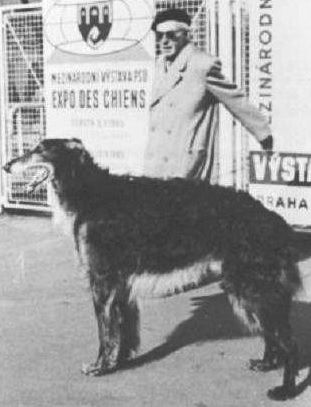
Calwarri z Neustejna is an excellent example of clever use of breeding material and was an eyeopener for breeders in the west. The picture show a self colored borzoi, perhaps he was black sable or maybe dark grey sable.
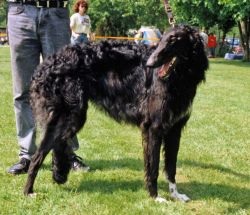
We can follow the bloodlines from Calwarri z Neusteijna to the self black Gem Black Sofena. From there it leads all the way to very strong lines of black borzoi in Czechia.
Neustejna and Sofena continued to breed occasional black borzoi. In about 1990 another breeder ecame active and has bred som excellent black borzois, the Majove kennels, later Majove Bohemia kennels.
It is interesting that in the Czech Republic with a growing “black borzoi culture”, breeders combines the domestic black borzoi with imports from the American lines of dominant blacks.
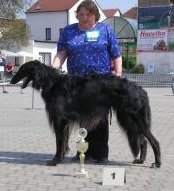
When we discuss black borzoi, we should remember that for most people a black dog, be it an Irish marked or a dominant self black, is a black dog. Breeders must learn about the genetics of their breed and use that knowledge to constantly improve their material. Others can look at a beautiful dog, see the shape of the head, the coat, the proportions, the color. The breeder must see beyond all that, examine the pedigree and see what the individual dog can add to the breed.
Examining the pedigrees of the selfcolored black borzoi in Europe we find two lines, Perchino and the one based on Chack Bielaja.
If we expand our view to the world we must incorperate a few other of the early Russian dogs. It is clear that some of the Perchino Borzoi carried black and tan, and some of the self-colored, especially the self grey (silver) were Dominant blacks, appearing silver because of the effect of the grizzle gene. We have also been told that even all-white dogs can carry the trait.
Black, tan and white borzoi has long been common in Australia, built on old British bloodlines. In later years imports have been made from both Europe and USA. Boronova Brastus is an example of a self black and tan leading back to the same Winjones Ataman mentioned above.
Study of the dogs genetics will perhaps give us better understanding and show us a clearer picture of what the borzoi really is. Perhaps a wolf in disguise? It can also give breeders in the future tools to use to continue to keep the breed healthy!
Present day science explains how the dominant black may have been inherited from the grey (silver), Vigow von der Moritzburg and the grey (silver) Yarki of Perchina via Chack Bielaja, Calwarri z Neustejna, to the Majove Bohemia in Europe and via the white Vigow and Akuratni of Romanoff to Black Falcon of Twin Elms and to Kristull Nickel of Rykha in the USA.
The only dominant black ancestor we with full certainty find in the early pedigrees is Chack Bielaja. This dog is present in the background of all modern borzoi and it seems that he’s bloodlines blended well with the overall dominating Perchino bloodlines!
If you want to learn more about color genetics you can visit this page: The Coat Color Genetics of Borzoi
Today all colors are allowed, with the exception for liver. Colors are a personal choice and one should not be preferred over another. The genepool is narrow and should not be reduced even more by breeding only for certain colors.
Credit to Andrus Kozlov, Sue Vasick, Dan Persson, Leonore Abordo, Kerry Olsson, Danielle Stenkamp, Danielle Laurent-Faure!
Author, Arvid Andersen
Editor, Sue Vasick
Year of Event:
Country:
Personal Collections:
Source:
Author:
Dogs:
Persons:

